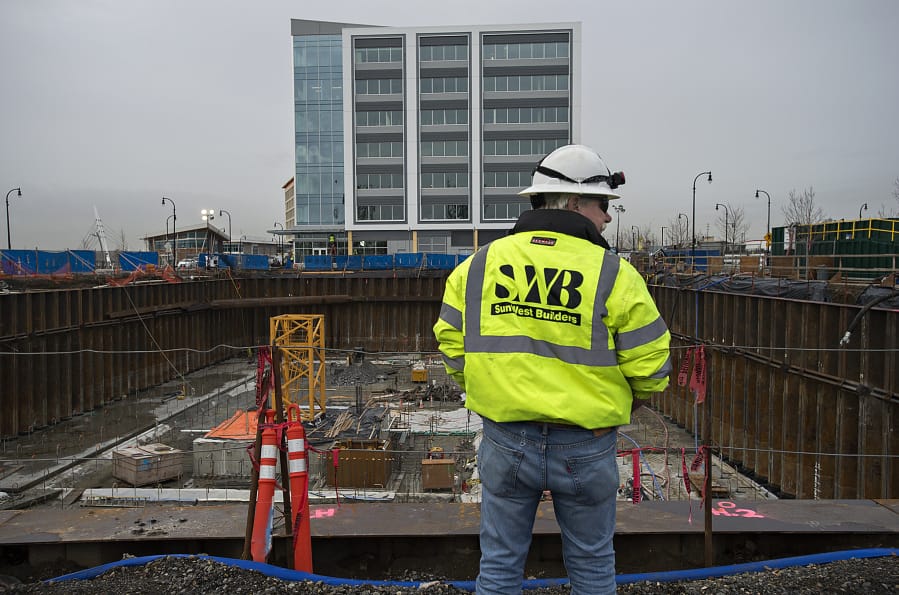Clark County’s unemployment rate climbed to 5 percent in December, an increase over November’s 4.6 percent but matching the 5 percent reported for December 2017, according to Washington Employment Security Department data released Wednesday.
Despite the rise in the unemployment rate, the county saw an unadjusted net increase of 200 jobs during December. When asked about the discrepancy, regional economist Scott Bailey stressed that the unemployment rate is an estimate.
“There’s a big plus-or-minus around that unemployment rate,” he said. “It has to move at least half a (percentage) point before we can say it was significantly different.”
Wholesale trade, information services, professional services, health care, food services and K-12 public education each gained approximately 100 jobs, but those gains were partially offset by a loss of 200 jobs in business services, 100 in state government and 100 in local government, resulting in a net gain of 200 jobs for the month, bringing total nonfarm employment to 170,400.
When reporting the state-level jobs numbers, the employment security department posts the actual change in jobs and a “seasonally adjusted” figure, which is recalculated to exclude large changes in the workforce that reliably occur at the same point in each year, such as thousands of students seeking summer jobs in June.
The county-level unemployment numbers are not seasonally adjusted, but in his own monthly report, Bailey said he calculated a seasonally adjusted estimate for Clark County which showed a net gain of 800 jobs for December, making it the best month since July.
It’s unclear if the ongoing partial shutdown of the federal government will have any measurable impact on Clark County’s job market, Bailey said. But if there is any impact, it won’t become visible until the January employment data is released.
Looking back at 2018 overall, Clark County added about 5,800 jobs. The resulting 3.5 percent growth rate exceeded city, state and national rates; the Portland region grew 1.9 percent in 2018, Oregon grew 1.5 percent, Washington grew 3 percent and the national rate grew 1.8 percent.
Clark County’s fastest-growing industry was construction and mining, with an increase of 1,600 jobs over the course of 2018. The trade, transportation and utilities sector added 1,000 jobs, and the leisure and hospitality, financial services, educational and health services and professional and business services industries each added 600.
Government also gained 500 jobs and manufacturing gained 100, but Bailey characterized those gains as weaker when evaluated as a percentage of total jobs in the industry.
“Another solid year of employment growth, (with) strong growth in construction,” Bailey said in summary. “Pretty balanced overall, only a couple of sectors that had slow job growth.”
Looking toward 2019, Bailey said he expected another good year, with positive job growth and no economic recession on the immediate horizon.
“We might see slowing because we’re near the peak of the business cycle,” he said, “although just because we’re near the peak doesn’t mean we’re close to a turnover. We can bounce around that peak for years if things are going right.”
Despite his optimism about the coming year, Bailey has also expressed concern about issues that he said could impact long-term economic growth. At The Columbian’s Economic Forecast Breakfast last week, Bailey called the county’s previous five years of consistent job growth “incredible,” but offered a warning about the rising danger of income inequality.
Clark County’s median income has increased for the past several years, he said, but the poverty rate has remained relatively unchanged, and the gains mostly went to the top 60 percent of earners, and those in the bottom 20 percent didn’t appear to have made any gains at all.
“Here, just as everywhere else, the upper end is doing much better than the lower end,” he said.
Bailey noted this week that the county doesn’t have as much of a wealth gap as some other areas. The county’s median household income, he noted, is above state and national averages.
“We tend to have a bit less poverty and a bit less on the upper-income side as well,” he said. “We’re more squished toward the middle.”
But as the county’s median income rises, he said, it’s important to pay attention to the higher-income jobs that are added. If those jobs are being filled by new residents moving to the area, then it doesn’t necessarily indicate that existing county residents are moving up the income ladder.




